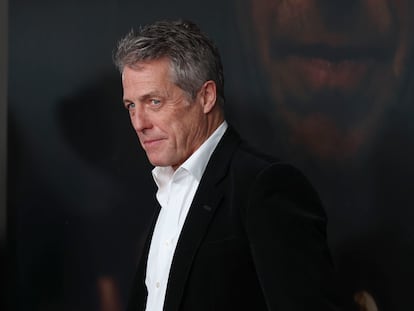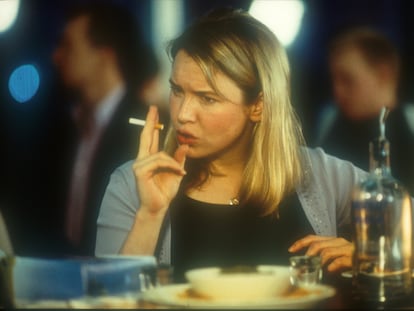Growing old with Bridget Jones means accepting the past wasn’t always better
In the fourth installment of the franchise, ‘Bridget Jones: Mad About the Boy,’ the protagonist is now a widow after Mark Darcy’s passing and finds herself falling for a man 22 years her junior

Bridget Jones has turned 51 having accomplished the goals she set for herself a quarter of a century ago: marry the love of her life, have children, lose weight to reach a normative body, and quit smoking. She still allows herself the occasional drink, though. As for her organizational skills and tendency for verbal incontinence, she still has work to do, but they don’t torment her as much as they did in the past.
The only real issue she faces in the fourth installment of the franchise, Bridget Jones: Mad About the Boy is that her relationship status has shifted from “married” to “widowed.” Mark Darcy (played by Colin Firth), the human rights lawyer, the knight in shining armor who always came to her rescue in the three previous films, has died in the line of duty, that is, on a humanitarian mission in Darfur. A hero to the end.
The film is set four years after Darcy’s murder. Bridget Jones has left her job as a television producer and has been raising her two young children all this time. She now lives in a multi-story house in north London and is trying to deal with grief and parenting. She still doesn’t comb her hair and doesn’t give much thought to her clothes — she doesn’t even take off her iconic Christmas pajamas to walk her children to school. But the real problem, which her friends and family identify from the start of the film, is that she needs to sleep with someone. Sex will solve everything, not love. Or so it seems.
This sets the stage for a plot that taps into the latest trend in romantic comedies: women between 40 and 50 who embark on relationships with much younger men. Think Babygirl, The Idea of You, A Family Affair, and Last Summer, among others. In Bridget Jones: Mad About the Boy, she begins flirting with Roxter, a 29-year-old guy she meets on the dating app Tinder. The film also challenges the typical labels and stereotypes — like MILF, cougar, or Mrs. Robinson — by presenting a woman who takes charge of her relationships without falling into the exaggerated caricature of Stifler’s mom from American Pie.
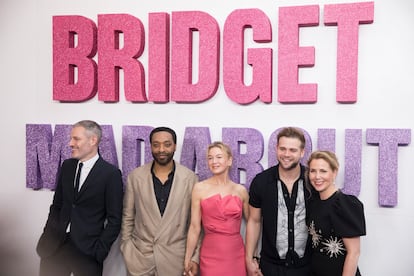
Director Michael Morris and Helen Fielding, the author of the books and one of the queens of chick lit, as well as the screenwriter for the films, have revisited the spirit of this era by placing Bridget at the center of this scenario. However, as with the previous three installments, embodying all the impositions of the heteronormative system, along with the limited escape routes available to half of the world’s population, carries its own risks and contradictions.
Bridget enjoys her relationship with a man 22 years younger, almost as a consolation prize for the death of her true love. But, as always in this saga, a third party emerges to complete the love triangle, offering the protagonist yet another path toward romantic fulfillment, which she has always pined for. There’s no way to separate Bridget Jones from the moral: they lived happily ever after, even if, this time, she seems much more liberated from some patriarchal constraints.
The main plot tells a new version of the story about a woman who, while retaining all her quirks, has minimized some of the traits that once made her so iconic. Fans need not worry — the references to Jane Austen’s Pride and Prejudice through Darcy and her new love interest are still there, and there are plenty of nods to the elements that made Bridget Jones a cultural icon: the music (the soundtrack remains top-notch), the Chardonnay, the giant panties, the miniskirts and sheer shirts, as well as her trademark clumsiness, translated into stumbles, insults, and close-ups of her behind. She is still that heroine who seems to have to pay the price of wallowing in the mud (both literally and metaphorically) in order to be liked.
A woman of her time?
The world met Bridget Jones at the age of 32 in 2001 in the hit movie Bridget Jones’s Diary. Back then, she was, in her own words, a spinster, fat, alcoholic, a smoker and a mess. And she was only in her early thirties. A woman whose only goal was to marry a man who would rescue her from the chaos, because only romantic love could save her.
In 2004, she was still the same when Bridget Jones: The Edge of Reason was released. She pressured Mark Darcy so much to propose that the lawyer got scared, and she almost ended up, once again, in the bed of Daniel Cleaver (Hugh Grant), the toxic man to whom she feels hopelessly attracted — until this latest installment, where, finally, they’re just friends.
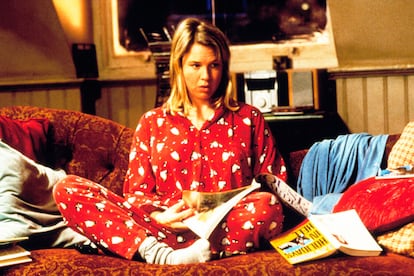
Since the first movie, there have been dozens of articles arguing that it has the right to expose the flaws of society, including those that affect women. At the same time, many others have been relentless in their criticism of Fielding’s books and films, accusing them of being sexist.
It wasn’t just about denouncing the idea that being overweight should be an insult, or that the only acceptable female physique at the time couldn’t be the so-called “heroin chic” of Kate Moss. Nor was it just about challenging the criminalization of women who drink, smoke, and are disorganized. The criticisms extended to other aspects, such as the multiple scenes in which the sexual harassment of various male characters, including Grant’s, was normalized.
The debate continued in 2016 with Bridget Jones’s Baby. Just before the #MeToo movement erupted, along with the latest wave of feminism, the protagonist became a geriatric mother (the medical term for pregnant women over 35), at a time when falling birth rates, infertility, job insecurity, and the inability to project a future after the 2011 economic crisis were already hot topics.
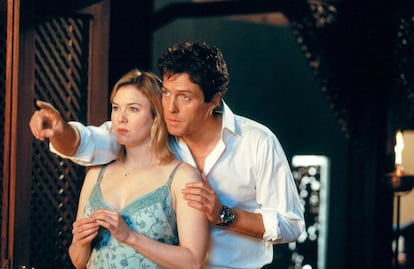
By then, Renée Zellweger’s character had already reached a socially accepted size, and her facial appearance had changed. The questions directed at the U.S. actress were no longer just about how she had gained and lost weight to play Jones, but also about whether she had undergone cosmetic surgery.
Tired of the scrutiny, Zellweger addressed the speculation in an op-ed for The Huffington Post: “Not that it’s anyone’s business, but I did not make a decision to alter my face and have surgery on my eyes. This fact is of no true import to anyone at all, but that the possibility alone was discussed among respected journalists and became a public conversation is a disconcerting illustration of news/entertainment confusion and society’s fixation on physicality.”
It doesn’t seem like this obsession has waned in 2025: we have moved from body positivity (freeing women’s bodies from rigid size expectations) to the Ozempic era (the diabetes medication that has become a Hollywood weight-loss trend, spreading by imitation to the rest of the world).
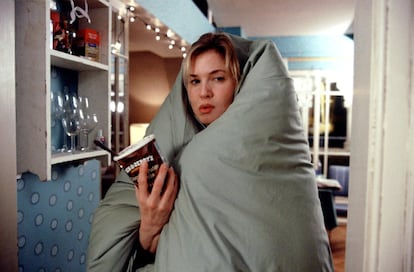
Revisiting the first three films in 2025 is a reminder that nostalgia doesn’t always mean the past was better — and that you don’t always have to return to the places where you were once happy. I shared this thought with my friends, all now in their late 30s and early 40s, as a kind of memory exercise to reflect on how we once perceived Bridget Jones. Once again, I found interpretations shaped by different moments in our lives — not necessarily mirroring Bridget’s, but allowing us, in our own ways, to see ourselves represented in the mainstream.
“A woman who wasn’t normative, like me, eating ice cream and drinking in her London bachelorette flat while singing All by Myself — that felt like my future self,” one friend said.
“I actually became her because I lived there, society punished us for not being skinny,” added another, a self-proclaimed fan of the books and films.
“Back then, she was just a free person trying to be happy,” said a third.
“The fact that Bridget considered herself fat says a lot about how we were raised,” another reflected. “I didn’t see her as fat, but I convinced myself she was because the movie told me so. And that was wrong too.”
We’ve found it more difficult to see ourselves in the current Bridget Jones at 51. Perhaps the best summary — one that our future selves will likely repeat if we revisit this conversation — came from a friend who responded when I asked her what she thought: “Bridget Jones is free, but she’s always seeking male validation through romantic love.” (We can get pretty intense on WhatsApp.) “Yeah, fine, but when is life not all fun and games?”
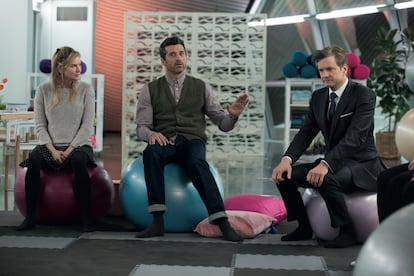
Sign up for our weekly newsletter to get more English-language news coverage from EL PAÍS USA Edition
Tu suscripción se está usando en otro dispositivo
¿Quieres añadir otro usuario a tu suscripción?
Si continúas leyendo en este dispositivo, no se podrá leer en el otro.
FlechaTu suscripción se está usando en otro dispositivo y solo puedes acceder a EL PAÍS desde un dispositivo a la vez.
Si quieres compartir tu cuenta, cambia tu suscripción a la modalidad Premium, así podrás añadir otro usuario. Cada uno accederá con su propia cuenta de email, lo que os permitirá personalizar vuestra experiencia en EL PAÍS.
¿Tienes una suscripción de empresa? Accede aquí para contratar más cuentas.
En el caso de no saber quién está usando tu cuenta, te recomendamos cambiar tu contraseña aquí.
Si decides continuar compartiendo tu cuenta, este mensaje se mostrará en tu dispositivo y en el de la otra persona que está usando tu cuenta de forma indefinida, afectando a tu experiencia de lectura. Puedes consultar aquí los términos y condiciones de la suscripción digital.
More information
Archived In
Últimas noticias
The United States designates Clan de Golfo as a foreign terrorist group
The United States strikes three more suspected drug boats, killing eight
The Iberian Peninsula is rotating clockwise, scientists report
Louis Tomlinson on surviving the loss of his mother, sister and One Direction bandmate: ‘There’s no preparation for what I’ve been through’
Most viewed
- Christian Louboutin: ‘Young people don’t want to be like their parents. And if their parents wear sneakers, they’re going to look for something else’
- ‘We are dying’: Cuba sinks into a health crisis amid medicine shortages and misdiagnosis
- A mountaineer, accused of manslaughter for the death of his partner during a climb: He silenced his phone and refused a helicopter rescue
- Cartels in Mexico take a leap forward with narco-drones: ‘It is criminal groups that are leading the innovation race’
- ‘El Limones’ and the growing union disguise of Mexican organized crime

